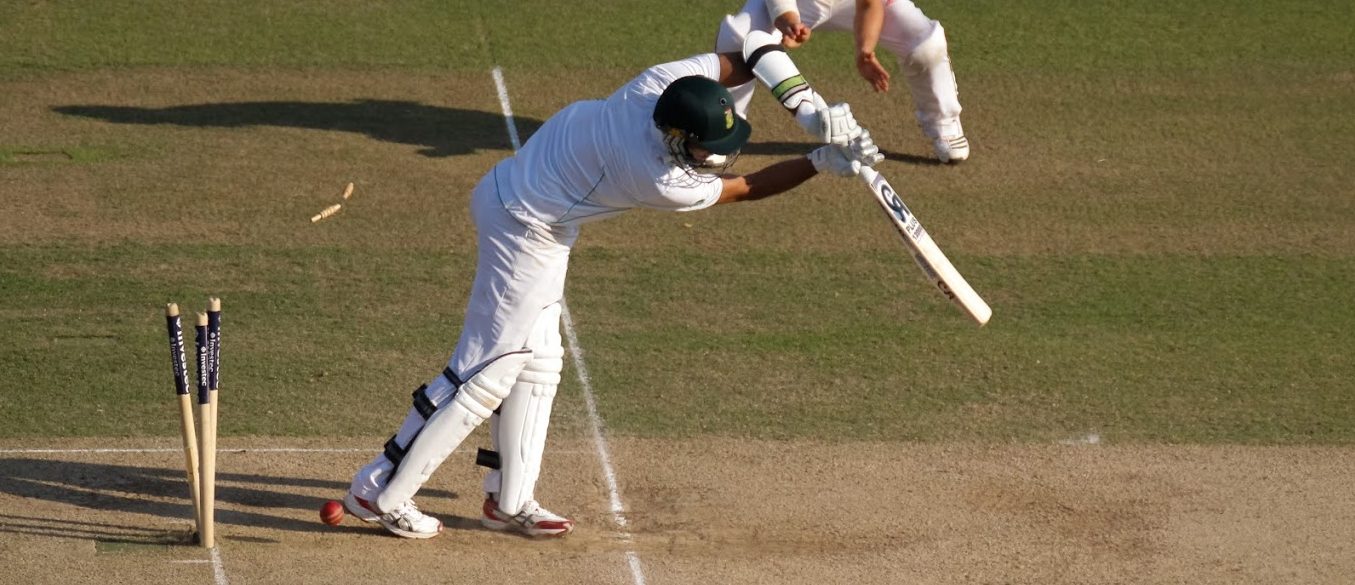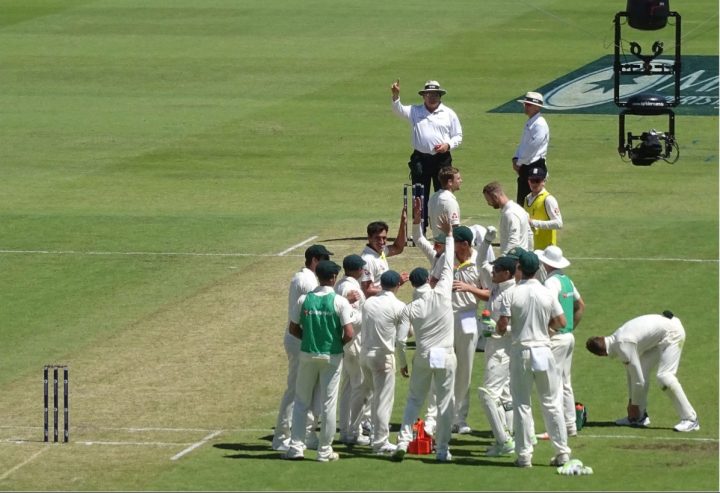For a non-contact sport cricket does have a habit of generating a wide range of injuries both on and off the pitch. The game is an uneven mix of energy and inactivity where athletic prowess hasn’t always been a prerequisite. Like any sport played on grass, players regularly negotiate knee and ankle injuries; strains, pulls and split fingers are battle scars for any cricketer. But players have a curious tendency to collect unusual injuries that are typical of the game’s eccentricity.
An Australian Premier League match in January 2017 provided a classic example of how the game can create its own brand of chaos. Footscray Edgewater versus Fitzroy Doncaster bore witness to the injury of three players with one ball! The striking batsman dispatched the ball to mid-on but his partner failed to avoid the trajectory. The ball whacked the non-striker on the heel who initially hobbled for a single. Then, realising the striker’s distress, stopped dead in his tracks. The ball was returned from the outfield and hit the bowler in the face.
Three players were left nursing injuries including the striker who strained his shoulder playing the shot. Incidents with a hard ball are an occupational hazard. As Aussie pace bowler Geoff Lawson once said, “there’s nothing like the sound of flesh on leather to get a cricket match going”.
However, I can’t conceal my amazement at players who pick up injuries before they even step on the pitch. Admittedly, they could happen to anyone but cricketers do seem more susceptible to injuries that are bad, embarrassing or downright painful. Their mishaps are obviously reported but it does seem to fall on cricketers more often than say footballers.
Take, for example, Jofra Archer who injured his hand cleaning a fish tank. In January 2021, he dropped the aforementioned item and slashed a tendon which was duly repaired in surgery. Reports vary as to the severity but he appeared to have damaged a finger. He missed two test matches against India and part of the IPL season. It felt symptomatic of his continuing struggle to stay fit; a troublesome elbow injury has prevented him from playing in half of England’s matches in all formats since his debut.
A player’s tendency to pick up injuries could be attributable to a number of factors, which could be genetic or a low level of fitness that hampers recovery time. A failure to properly warm up and warm down can also have an effect and result in strain injuries, even when they’re not playing.
Glenn McGrath looked to be in ominously good form when he tore through England’s batting line-up in the first Test at Lords in 2005. McGrath clocked up his 500th Test wicket and was ready to make mischief in the rest of this historic Ashes Series. Warming up for the second Test at Edgbaston somebody suggested a game of touch rugby. Risking accusations of schadenfreude, there aren’t many England fans who wouldn’t thank that unfortunate individual.
The impromptu rugby session resulted in McGrath treading on a stray cricket ball and tearing lateral ligaments in his right ankle. It put him out of the second Test as England squeezed home by two agonising runs. But he returned for the third test and took a highly creditable 19 wickets in the series – even though he wasn’t firing on all cylinders. Playing rugby as warm up for a game of cricket doesn’t score highly in the logic department. Jimmy Anderson similarly parted with common sense; although it was another team bonding exercise at the root of his downfall.
Andy Flower’s ill-conceived boot camp prior to the Ashes in 2010 was always likely to end in tears. After a long and gruelling season the players were desperate for some rest prior to the Ashes tour. However, it was decreed the squad would fly out to Germany for a five day boot camp instead. Separated from their families and being confronted with physically demanding exercises did not lighten the players’ moods. Anderson subsequently broke a rib in a boxing session with an unnamed teammate.
A broken rib takes two months to properly heal; so it was touch and go whether Anderson would recover in time for the first Test at Brisbane. He eventually played, bowled 42 overs and helped England to a hard earned draw. So no harm done. But was it worth the angst of an unsettled team in the build-up?
The incidents involving McGrath and Anderson begger belief in the sense that they were sustained playing contact sports – something cricketers simply aren’t used to. Boxing requires combatants to properly defend themselves, touch rugby frequently turns into the real thing, and I have rarely seen a game where the touch element doesn’t slip players’ minds. These injuries were reasonably foreseeable and easily avoided.
Then we have the injuries that occur far and away from the cricket pitch, the seemingly harmless activities that couldn’t pose less risk of injury. All-rounder Derek Pringle managed to injure his back on the eve of a Test match against Pakistan in 1982. Whilst sealing envelopes he leaned back in his chair which collapsed, causing a spasm between the shoulder blades. Not wishing to bother the England physio he slept on a mattress on the floor. He only succeeded in making the condition worse and had to be replaced.
Such injuries are often the result of cumulative damage caused by years of bad posture. The late Tony Grieg was once forced to miss a Test match when he cricked his neck whilst shaving. Crouching down to see a mirror doesn’t do you any favours when you’re six feet seven. Chris Old was an England stalwart for nine years taking 143 wickets and scoring 2 half centuries in 46 test matches. Ostensibly a medium pace bowler he was also a decent bat and scored 6 first class centuries for Yorkshire. Old became a quasi all-rounder and frequently provided a useful foil for Ian Botham as they shored up the middle order.
But it was Old’s shocking catalogue of injuries that obscured an otherwise fine career. He had ongoing issues with his knees and could never stay fully fit. His travails became the stuff of legend as the bowling machine at Lords was known as ‘Chris Old’ because it broke down so often. For someone so injury prone, the ignominy was complete when he sneezed and cracked a rib.
There are however, genuinely freakish injuries that are totally random but by their very nature more serious. Ted Dexter was captain of Sussex and England; he played in 62 tests and was a bone fide cricket idol. In 1965, he was cruising on the Great West Road when his Jaguar ran out of petrol. He pushed said vehicle to the nearest garage, but somehow ended up trapped between the vehicle and a factory gate and broke his leg in the process. However Lord Ted happily recovered sufficiently for one last flourish in England colours three years later.
Ian Grieg had a brief two Test career in 1982 but was a solid all-rounder for Sussex and Surrey. His trip to A & E was the result of a broken key and an invitingly open window. With no other means of entry, Grieg climbed up the side of the house but fell 18 feet and broke his ankle. Some would say he got away lightly bearing in mind how far he fell. Bruce French undoubtedly trumped Grieg in the injury stakes. The Notts and England wicket-keeper was enjoying a spot of net practice in Lahore when he was hit by a ball. Whilst waiting outside the hospital he was hit by a car and needed stitches. To cap a perfect day, French hit his head on a light fitting as he got up to leave!
The most remarkable comeback from injury must surely belong to spin bowler Fred Titmus. In 1968, he was an established England player touring the West Indies. Prior to the third Test he was relaxing on the beach and went for a swim. However, his left foot was caught in the propeller of a motor boat and he lost four toes. Such a gruesome injury would surely have been the end for any athlete; after all the toes help the body balance and distribute weight. Yet within a year he was back playing county cricket and took 111 wickets. As a spinner he had no requirement for a long run-up; it might have been a different story for a seamer. Titmus played at top level for another eight years and even won an England recall aged 42.
Perhaps the final word on freak injuries should come from legendary writer Arthur Conan Doyle. The creator of Sherlock Holmes was a good cricketer and played 10 first class games for the MCC. In 1903, he was in the side that faced Kent at Lords. With the score at 116 for 9, Doyle was running out of partners. However, a fast delivery hit Doyle on the thigh and ignited a tin of Vesta matches in his pocket. He was a batsman literally on fire. As Doyle later recalled, “a little occasional pain is one of the chances of cricket, and one takes it as cheerfully as one can!“
Brian Penn









Very good piece Brian.
It seems to me that although as you say, cricketers seem to be a bit injury prone, it’s more frequent these days. Surrey had 7 players injured BEFORE the start of the season last year! There are a number of reasons for this:
1. Over emphasis on ” fitness”. Cricketers don’t need to be Olympic athletes, but you’d never know it with all the fitness coaches, gym workouts and running around the pitch. Gooch started this in the 80s, and while it suited him, Botham commented that he gave his all for 6 hours on the pitch, and wasn’t going to run around the ground for anyone.
2. Cricket is very stop and start and the best way to get ready for it is to play it, not “rest”, not go on needless training regimes and certainly not play football before the start of a game.
3. I am a veteran long distance swimmer. I have swum the Channel 3 times. At no point did I ever train in a gym or run 3 miles. I had a great coach, and swimming was my training. I am 74, still swim 3 miles a week year round in an open air pool, and I have never, repeat never, had an injury that kept me out of the water. You work through the minor twinges. In my younger days I was a surfer for years and apart from cuts on rocks and reefs never sustained an injury caused by the physical side of actual surfing.
4. We’ve got too high tech with sports coaching and injury “management”. Fred Trueman played 20 + odd 3 day Championship games and every test match a summer. Injuries? As far as I recall he was never out for injury. “You won’t get fit sitting in the dressing room lad” said Boycott. Wilfred Rhodes was recalled to the Test side at the age of 53 and took a five for. Jack Hobbs scored more runs after the age 40 than before.
4. Keep it simple and get rid of expensive sports consultants, personal trainers and all the hangers on who are contributing to the parlous state of English cricket.
Thanks Doug – Good for you being so active, an example to us all! I think you’re right, players do ‘over train’ to a ridiculous extent these days. They are often treated like engines that can be fine tuned, and the worst thing anyone could do is be a slave to personal trainers, dietitians, body movement coaches or whatever fitness fad is doing the rounds.
Ross Taylor’s injury always makes me wince:
https://www.smh.com.au/sport/cricket/new-zealand-cricketer-ross-taylor-out-two-months-after-protector-didnt-protect-20150820-gj41ak.html
Of course the most famous blow in the nether regions was Thommo striking David Lloyd in 1974/75. Richie Benaud commented that the England batsman had boasted he’d played the Australian bowlers with “his appendage” and Thommo had merely given him the opportunity.
Lovely article that.
Can’t say I’ve noticed that the players are more accident prone in the amateur game more than in any other sport, but playing at the highest level cricket’s unnatural physical movements are accentuated. If you look at baseball, where batters and pitchers swipe at and throw the ball in a purely natural way they seem to have fewer injury issues, spending half their life in the gym developing suitably robust physiques. The problem for cricket bowlers and batters is they use the bat and ball in unnatural physical positions, using muscles they don’t put stress on in normal life, twisting and turning with sudden movements, hence the litany of injuries doing apparently innocuous everyday things. I’ve always felt that normal gym activities will only accentuate the pressures on these special stresses so increasing the chance of tweaking muscles.
There was a centrefold in the cricketer many moons ago of Graham Dilley in his delivery stride. It showed a positively balletic pose where Dilley’s entire body weight appeared to be balanced on his big toe. Indeed such was the stress he had the toe cut out if his boot to allow his big toe room to move as he dragged his foot before release. Just what strain this put on other parts of his body God only knows, as this happened with every ball he bowled.
As a senior player I can tell you that the injuries become more and more frequent as the years roll by. A mate of mine played for an over sixties county team and relates this story…
We were batting and doing well. One player, well set on 30 – odd, was looking to push the score along with some ‘quick’ singles (these terms are all relative!). A new batsmen was on stride and punched a wide one through the covers. A shout for a single caused him to come out of his forward position too quickly and he pulled a muscle in his back. Meanwhile, the cover fielder tried vainly to stop the ball, stumbled and dislocated a thumb as he hit the deck. The sweeper on the boundary gathered up the ball and threw it in, only to wreck his shoulder with the effort.
Peter Drake teacher and cricket nut Hexham
There’s a scenario on Facebook of a village game where a rather portly batsman smote an even more portly bowler over his head took off to run and tripped over mid pitch, meanwhile the bowler had turned to chase the ball and flattened the non strikers stumps as he ran into them. The batsman got up and continued his run having left his bat in mid pitch and in attempting a second tripped and fell again as he went to pick it up on his way past. Whilst this was going on the keeper received the ball but everyone was laughing so much he just lobbed the ball back to the bowler shrugging his shoulders in disbelief and the game continued with 2 added to the score. Another case of how stats never tell the whole story.
Thanks For Sharing This Blog And if you are looking for Latest Cricket News of IPL 2022 and Word wide cricket please check CricobetNewz, This is the best platform where your can get daily basis cricket news and also you can do here Guest Post if you are a writer and do you love cricket writer for us and we will grow together
Nice article, thanks. Another unfortunate accident was that of Colin Milburn, who lost an eye in a car accident not long after his (thrilling) debut for England. Colin did attempt a comeback a couple of years later, but was never the same.